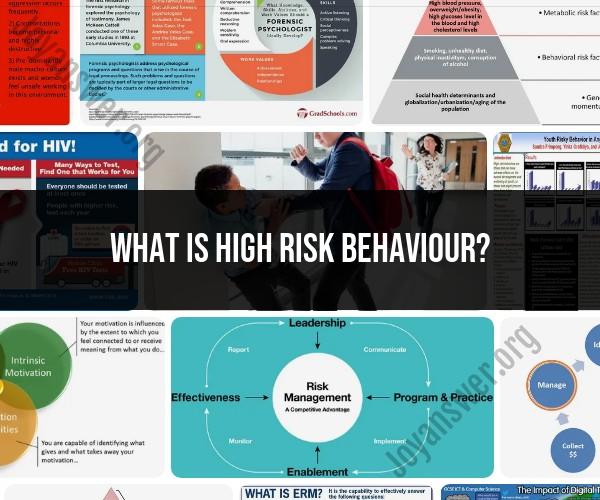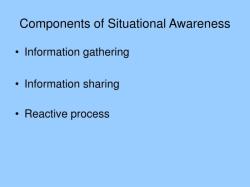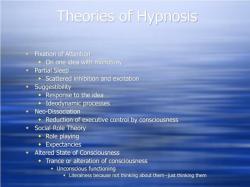What is high risk behaviour?
High-risk behavior refers to actions, activities, or behaviors that have a significant likelihood of resulting in negative consequences, harm, or adverse outcomes. These behaviors are often associated with a higher-than-average chance of injury, illness, damage, or legal, social, or psychological problems. High-risk behaviors are characterized by their potential to cause harm to oneself or others and are typically considered dangerous or unhealthy.
Examples of high-risk behaviors include:
Substance Abuse: The excessive or irresponsible use of drugs, alcohol, or other substances, leading to addiction, health issues, accidents, and legal problems.
Reckless Driving: Engaging in aggressive or dangerous driving behaviors, such as speeding, driving under the influence, or distracted driving, which can lead to accidents and injuries.
Unsafe Sexual Practices: Engaging in unprotected sex, multiple sexual partners, or other risky sexual behaviors that increase the risk of sexually transmitted infections (STIs) and unplanned pregnancies.
Self-Harm: Deliberate acts of self-injury or self-destructive behavior, often driven by emotional distress or mental health issues.
Extreme Sports: Participation in high-risk or extreme sports and activities that involve physical danger, such as skydiving, rock climbing, or BASE jumping.
Criminal Activities: Engaging in illegal activities, such as theft, violence, or drug trafficking, which can lead to legal consequences, imprisonment, or physical harm.
Unhealthy Eating Habits: Adopting poor dietary habits, such as excessive consumption of fast food, sugary beverages, or a diet lacking in essential nutrients, leading to obesity and related health problems.
Gambling: Excessive or compulsive gambling, which can result in financial ruin, addiction, and strained relationships.
Tobacco and Nicotine Use: Smoking or using other tobacco or nicotine products, which is a leading cause of preventable diseases like cancer and heart disease.
Risky Financial Behavior: Making impulsive financial decisions, accumulating high levels of debt, or failing to save for the future, leading to financial instability and stress.
High-risk behaviors are often associated with impulsivity, peer pressure, mental health issues, or a lack of awareness about the potential consequences. Preventing and addressing high-risk behaviors typically involve education, counseling, support, and, in some cases, intervention or treatment to mitigate the associated risks and promote healthier choices and lifestyles.
High-Risk Behavior: Understanding the Concept
High-risk behavior is any behavior that increases the risk of negative consequences, such as injury, illness, death, or social problems. High-risk behaviors can be intentional or unintentional, and they can be engaged in by people of all ages and backgrounds.
Some examples of high-risk behaviors include:
- Substance abuse (alcohol, drugs, tobacco)
- Sexual activity without protection
- Risky driving behaviors (speeding, distracted driving, driving under the influence)
- Violence (assault, bullying, self-harm)
- Eating disorders
- Gambling
- Crime
Risky Behaviors: Examples and Implications
The implications of risky behaviors can vary depending on the type of behavior and the individual engaging in the behavior. However, some common implications of risky behaviors include:
- Physical injury or death
- Illness or disease
- Addiction
- Mental health problems
- Legal problems
- Social problems (relationship problems, job loss, etc.)
Exploring High-Risk Behavior: Causes and Consequences
There are a number of factors that can contribute to high-risk behavior, including:
- Peer pressure
- Mental health problems
- Substance abuse
- Trauma
- Lack of supervision
- Impulsivity
- Lack of knowledge about the risks
- Socioeconomic factors
The consequences of high-risk behavior can be severe and long-lasting. They can impact an individual's physical and mental health, their relationships, their education, their career, and their overall quality of life.
Preventing High-Risk Behavior
There are a number of things that can be done to prevent high-risk behavior, such as:
- Providing education and awareness about the risks
- Teaching coping skills and resilience
- Creating supportive environments
- Monitoring and supervising young people
- Providing access to treatment and support services
If you are concerned about your own or someone else's high-risk behavior, it is important to seek help. There are a number of resources available, including mental health professionals, substance abuse treatment programs, and hotlines.













